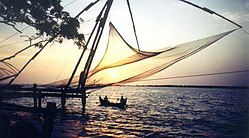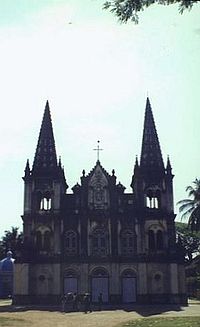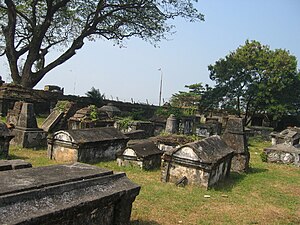History of Kochi, Kerala
| Timeline of Kochi | |

| |
| Year | Event |
| 1102 AD | The kingdom of Kulasekhara breaks up, and the Cochin State is formed. |
| 1341 AD | The port at Kodungallur is destroyed in a massive flodding in the Periyar. The prominece of Kochi as a trading post increases. |
| 1440 AD | Italian traveller Niccolò Da Conti visits Kochi |
| 1500 AD | Portuguese Admiral Pedro Álvares Cabral, lands at Kochi. |
| 1503 AD | Kingdom of Kochi is taken over by the Portuguese. |
| 1530 AD | Saint Francis Xavier arrives and introduces a Christian mission. |
| 1663 AD | Portuguese rule overthown by the Dutch. |
| 1773 AD | Mysore King, Hyder Ali's conquest descends on Kochi. |
| 1773 AD | Mysore King, Hyder Ali's conquest descends on Kochi. |
| 1814 AD | Anglo-Dutch Treaty of 1814 officially passes the city to the United Kingdom |
| 1947 AD | India gains independence, Kochi joins the Indian Union. |
| 1956 AD | The State of Kerala is formed. |
| 1967 AD | Kochi Corporation comes into existence. |
Kochi (Template:Audio; Malayalam: കൊച്ചി [Kocci]); formerly known as Cochin) is a city in the Indian state of Kerala. Kochi is located in the district of Ernakulam, about 220 km north of the state capital Thiruvananthapuram. Old Kochi loosely refers to a group of islands including Willingdon Island, Fort Kochi and Mattancherry. Today Kochi includes Ernakulam, old parts of Kochi, Kumbalangi, and outlying islands.
For many centuries up to and during the British Raj, the city of Kochi was the seat of the eponymous princely state. Kochi traces its history back many centuries, when it was the centre of Indian spice trade for many centuries, and was known to the Yavanas (Greeks and Romans), Jews, Arabs and Chinese since ancient times.[1] Kochi earned a significant position on the world trading map after the port at Kodungallur (Cranganore) was destroyed by massive flooding of the river Periyar in 1341 AD.[2]
The earliest documented references to Kochi occur in the books written by Chinese voyager Ma Huan, during his visit to Kochi in the 15th century as part of the treasure fleet of Admiral Zheng He.[3] There are also references to Kochi in accounts written by Italian traveller Niccolò Da Conti, who visited Cochin in 1440 AD.[4].
Today, Kochi is the commercial hub of Kerala[5], and one of the fastest growing second-tier metros in India.[6]
Prehistory
Not much is known about the prehistory of Kochi. There has been no clear evidence of Stone Age inhabitation. Quite ironically, Kochi forms the central part of the Megalithic belt of Kerala. The only trace of prehistoric life in the region is the menhir found in Tripunithura.
Princely rule
The history of Kochi prior to the Portuguese is not well documented. Though places north and south of Kochi are mentioned in quite detail in many accounts by ancient travellers, even a mention of Kochi is absent prior to the arrival of the Portuguese. Kochi's prominence as a trading port grew after the collapse of the port at Kodungallur in 1341 AD.
The Cochin State came into existence in 1102 AD after the breaking up of the Kulasekhara empire[7]The King of Kochi had authority over Cochin and adjoining areas. The Royal Family that ruled over Kochi was known as Perumpadappu Swaroopam. Till the end of the 12th century, the State was headquartered at the village of Perumpadappu. However, since the 18th century, mainland Kochi has remained the capital of the State.
Rulers of Kochi
- Unni Ramman Koyil - 11 (1503 – 1537)
- Veera Kerala Varma (1537 – 65)
- Keshava Ramavarma (1565 –1601)
- Veerakerala Varma (1601 – 15)
- Ravivarma (1615 – 24)
- Veera Kerala Varma (1624 – 1637 )
- Godhavarma (1637 – 45 )
- Veera Rayira Varma (1645 – 46 )
- Veerakerala Varma (1645 – 50 )
- Ramavarma ( 1650 – 56 )
- Rani Gangadhara Lakshmi ( 1656 – 58 )
- Ramavarma ( 1658 – 62 )
- Godhavarma ( 1662 – 63 )
Foreign rule
Kochi was under the rule of many foreign empires, during which the Raja of Kochi still remained the titular head.
Portuguese period (1503 — 1663)

Kochi was the scene of the first European settlement in India. In the year 1500, Portuguese Admiral Pedro Álvares Cabral landed first at Calicut. Soon after, the Portuguese fleet engaged in a naval action against a Kochi trading ship carrying elephants (allegedly assuming that it was a spice-carrying Muslim trader). The Portuguese fleet remained in Calicut for three months, while waiting to load its spice cargo. Then, upon suspecting that competing Muslim traders were being loaded more promptly, the Portuguese attacked a moored Muslim ship. In the ensuing commotion, forty Portuguese sailors were killed in the city. After bombarding the city in retaliation, the Portuguese fleet moved to Kochi. The King of Kochi welcomed his guests and a treaty of friendship was signed. Promising his support in the conquest of Calicut, the admiral coaxed the king into allowing them to build a factory at Cochin. Assured by the support, the king called war with the Zamorins of Calicut. However the Portuguese admiral retreated with his cargo on seeing the powers of the Zamorin. The Zamorins, on the other hand, eager to win the favor of the Portuguese, left without a war. Another captain, Joao Da Nova, was sent in place of Cabral. However he too faltered at the sight of the Zamorin. The consecutive retreats made the King of Portugal indignant. Portuguese chronicles, however, tell a different story: according to João de Barros (1496 – October 20, 1570), Joao Da Nova was repeatedly victorious in naval actions against Calicut.
The Portuguese king then sent Vasco Da Gama, who bombed Calicut and destroyed the Arab trading posts. This invited the anger of the Zamorin, who declared a war against the Kochi Raja.

The war between Calicut and Cochin began on 1 March 1503. Rather than delivering the forty Portuguese men present in Cochin, the king took refuge in the sacred island of Vypin with his protegées. However, the oncoming monsoons and the arrival of a small Portuguese fleet under Afonso de Albuquerque alarmed the Zamorin, and he called back his army. The Zamorin resorted to a retreat also because the revered festival of Onam was near, and the Zamorin intended to keep the auspicious day holy. This led to a triumph for the king of Kochi, who was later re-established in the possession of his kingdom. However, much of the kingdom was burnt and destroyed by the Zamorins. In 1504, some time after the departure of Albuquerque's fleet toward Portugal, the war betwen Calicut and Cochin resumed. The Portuguese presence in Cochin was successfully defended by two caravels and a few hundred men under the command of Duarte Pacheco Pereira against far superior forces.
The Portuguese built a Fort — Fort Manuel (after the reigning king of Portugal), surrounding the Portuguese factory, in order to protect it from any further attacks. The entire work was commissioned by the Cochin Raja, who supplied workers and material. The Raja continued to rule with the help of the Portuguese. Meanwhile, the Portuguese secretly tried to enter into an alliance with the Zamorins. A few later attempts by the Zamorin at conquering the Kochi port were thwarted by the Cochin Raja with the help of the Portuguese. Slowly, the Portuguese armory at Kochi was increased, with the presumed notion of helping the raja protect Kochi. However, the measured led to decrease in the power of the Cochin Raja, and an increase in the Portuguese influence. From 1503 to 1663, Kochi was ruled by Portugal through the namesake Cochin Raja. Kochi remained the capital of Portuguese India till 1510. In 1530, Saint Francis Xavier arrived and founded a Christian mission. This Portuguese period was difficult for the Jews installed in the region, since the Inquisition was active in Portuguese India. Kochi hosted the grave of Vasco da Gama, the Portuguese viceroy, who was buried at St. Francis Church until his remains were returned to Portugal in 1539.[8] Soon after the time of Albuquerque, the Portuguese rule in Kerala declined. The failure is attributed to several factors like intermarriages, forcible conversions, religious persecution etc.
Dutch period (1663 — 1773)
The Portuguese rule was followed by that of the Dutch, who had by then conquered Quilon, after various encounters with the Portuguese and their allies. Discontented members of the Cochin Royal family called on the assistance of the Dutch for help in overthrowing th Cochin Raja. The Dutch successfully landed at Njarakal and headed on to capture the fort at Pallippuram, which they handed over to the Zamorin.
Mysorean invasion
The 1773 conquest of the Mysore King Hyder Ali in the Malabar region descended to Kochi. The Kochi Raja had to pay a subsidy of one lakh of Ikkeri Pagodas (equalling 4 lakh modern rupees). Later on, in 1776, Haider capture Trichur, which was under the Kingdom of Kochi. Thus, the Raja was forced to become a tributary of Mysore and to pay a nuzzar of 1 lakh of Pagodas and 4 elephants and annual tribute of 30,000 Pagodas. The hereditary Prime Ministership of Cochin came to an end during this period.
English Period (1841 — 1947)
In 1814 according to the Anglo-Dutch Treaty, the islands of Kochi, including Fort Kochi and its territory were ceded to the United Kingdom in exchange for the island of Banca. Even prior to the signing of the treaty, there are evidence of English residents in Kochi.[9] Towards the early 20th century, trade at the port had increased substantially, and the need to develop the port was greatly felt. Harbour Engineer Robert Bristow, was thus brought to Cochin in 1920 under the direction of Lord Willingdon, then the Governor of Madras. In a span of 21 years, he had transformed Cochin as the safest harbour in the peninsula, where ships berthed alongside the newly reclaimed inner harbour equipped with a long array of steam cranes.[10] Meanwhile, in 1866, Fort Cochin was made a municipality, and its fist Municipal Council election to a board of 18 members was conducted in 1883. The Maharajah of Cochin, in 1896 initiated local administration, by forming town councils in Mattancherry and Ernakulam. In 1925, Kochi legislative assembly was constituted due to public pressure on the state. The assembly consisted of 45 members, 10 of who were officially nominated. Thottakkattu Madhaviamma became the first woman to be a member of any legislature in India.[11]
Post Independence era
In 1947, India gained independence from the British colonial rule. Cochin was the first princely state to join the Indian Union willingly.[12] Post independence, Ikkanda Warrier became the first Prime Minister of Kochi. K.P.Madhavan Nair, P.T Jacob, C. Achutha Menon, Panampilly Govinda Menon were few of the other stalwarts who were in the forefront of the democratic movements. Then in 1949, Travancore-Cochin state came into being by the merger of Cochin and Travancore, with Paravur T.K Narayana Pillai as the first chief minister. Travancore-Cochin, was in turn merged with the Malabar district of the Madras State. Finally, the Government of India's November 1, 1956 States Reorganisation Act inaugurated a new state — Kerala — incorporating Travancore-Cochin, Malabar District, and the taluk of Kasargod, South Kanara.[13] On the 9th of July, 1960, the Mattancherry council passed a resolution that was forwarded to the government, requesting the formation of a Municipal Corporation by combining the existing municipalities of Fort Kochi, Mattancherry and Ernakulam. The proposal was condemned by the Fort Kochi municipality. However, the Ernakulam municipality welcomed the proposal, suggesting the inclusion of more suburban areas in the amalgamated Corporation. Major Balagangadhara Menon, the then Director of Local Bodies was appointed by the government to study the feasibility of the suggested merger. And based on the report submitted by him, the Kerala Legislative Assembly approved the formation of the Corporation. Thus, on the 1st of November 1967, exactly 11 years since the conception of the state of Kerala, the corporation of Cochin came into existence, by the merger of the municipalities of Ernakulam, Mattancherry and Fort Kochi, along with that of the Willingdon Island and four panchayats viz. Palluruthy, Vennala, Vyttila and Edappally and the small islands of Gundu and Ramanthuruth.
References
- João de Barros Da Ásia de João de Barros e de Diogo do Couto : dos feitos que os portugueses fizeram no descobrimento dos mares e terras do Oriente (in Portuguese)
See also
Template:Topics related to Kochi (India)
Notes
- ↑ History of Ernakulam. Ernakulam Portal. National Informatics Centre. Retrieved on 2006-05-23.
- ↑ Emergence of Kochi harbour. History of Kochi. Centre For Heritage Studies, India. Retrieved on 2006-05-23.
- ↑ Ma Huan: Ying Yai Sheng Lan &mdsh; translated by J.V.G. Mills (1970). The Overall Survey of the Ocean's Shores. Hakluyt Society , White Lotus Press. ISBN 974-8496-78-3.
- ↑ Accounts of Nicolo de' Conti (ca.1395-1469). Niccolo di Conti. win.tue.nl. Retrieved on 2006-05-23.
- ↑ The Economy of Kochi— Trade & Industry in Kochi. Kochi Corporation. Retrieved on 2006-05-23.
- ↑ Rakee Mohan. Developing metro and quaint environs, Economic Times, 2006-04-08. Retrieved on 2006-05-23.
- ↑ Prehistory and Archaeology of Cochin. Corporation of Cochin. Retrieved on 2006-05-23.
- ↑ Death of Vasco Da Gama in Kochi. MSN Encarta Encyclopedia. Microsoft. Retrieved on 2006-05-23.
- ↑ Kochi Rajyacharithram by KP Padmanabha Menon. P(1914)
- ↑ The Cochin Saga. Robert Charles Bristow employed to develop Kochi port. Corporation of Kochi. Retrieved on 2006-05-23.
- ↑ History and culture of Kochi. Corporation of Kochi. Retrieved on 2006-05-23.
- ↑ History and culture of Kochi. Corporation of Kochi. Retrieved on 2006-05-23.
- ↑ Plunkett, R, Cannon, T, Davis, P, Greenway, P & Harding (2001). Lonely Planet South India, Lonely Planet. ISBN 1-86450-161-8.

